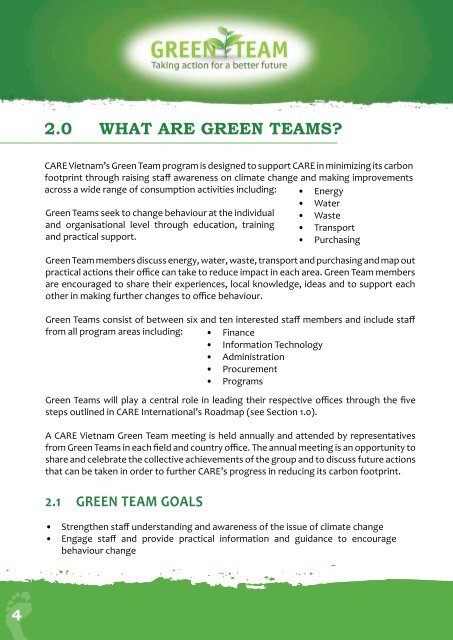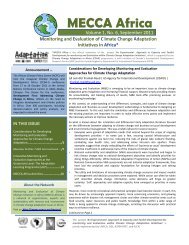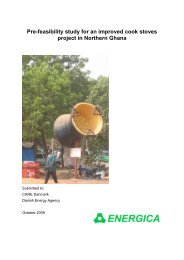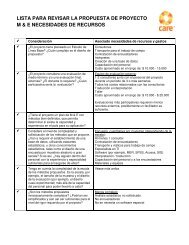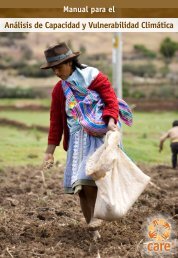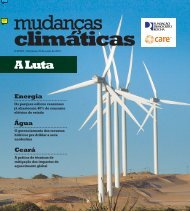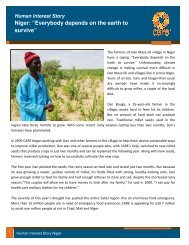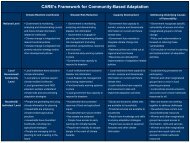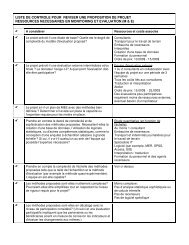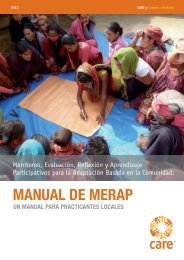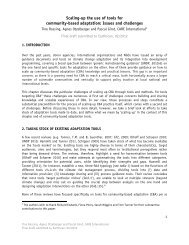Green Action Handbook - CARE Climate Change
Green Action Handbook - CARE Climate Change
Green Action Handbook - CARE Climate Change
Create successful ePaper yourself
Turn your PDF publications into a flip-book with our unique Google optimized e-Paper software.
• Reduce <strong>CARE</strong> Vietnam’s greenhouse gas emissions by increasing energy and water<br />
efficiency, minimising waste, and implementing green procurement practices<br />
• Ensure each field and country office concerns are met<br />
• Research potential future solutions<br />
2.0 WHAT ARE GREEN TEAMS?<br />
<strong>CARE</strong> Vietnam’s <strong>Green</strong> Team program is designed to support <strong>CARE</strong> in minimizing its carbon<br />
footprint through raising staff awareness on climate change and making improvements<br />
across a wide range of consumption activities including: • Energy<br />
• Water<br />
<strong>Green</strong> Teams seek to change behaviour at the individual • Waste<br />
and organisational level through education, training • Transport<br />
and practical support.<br />
• Purchasing<br />
<strong>Green</strong> Team members discuss energy, water, waste, transport and purchasing and map out<br />
practical actions their office can take to reduce impact in each area. <strong>Green</strong> Team members<br />
are encouraged to share their experiences, local knowledge, ideas and to support each<br />
other in making further changes to office behaviour.<br />
<strong>Green</strong> Teams consist of between six and ten interested staff members and include staff<br />
from all program areas including: • Finance<br />
• Information Technology<br />
• Administration<br />
• Procurement<br />
• Programs<br />
<strong>Green</strong> Teams will play a central role in leading their respective offices through the five<br />
steps outlined in <strong>CARE</strong> International’s Roadmap (see Section 1.0).<br />
A <strong>CARE</strong> Vietnam <strong>Green</strong> Team meeting is held annually and attended by representatives<br />
from <strong>Green</strong> Teams in each field and country office. The annual meeting is an opportunity to<br />
share and celebrate the collective achievements of the group and to discuss future actions<br />
that can be taken in order to further <strong>CARE</strong>’s progress in reducing its carbon footprint.<br />
2.1 GREEN TEAM GOALS<br />
• Strengthen staff understanding and awareness of the issue of climate change<br />
• Engage staff and provide practical information and guidance to encourage<br />
behaviour change<br />
2.2 HOW DO GREEN TEAMS WORK?<br />
Each office floor is assigned one or more <strong>Green</strong> Team members. <strong>Green</strong> Team members<br />
conduct informal and fun training for their floor on topics such as ‘how to print double<br />
sided’, ‘how to recycle’ and ‘how to use the air conditioner responsibly’. These trainings<br />
may be every three to six months. <strong>Green</strong> Team members are available to answer questions<br />
and provide support to staff on their floor.<br />
In recognition of the voluntary efforts and commitment of individual staff members <strong>CARE</strong><br />
Vietnam has committed to providing greater institutional support, including allocating<br />
resources and staff time to their efforts, encouraging senior staff to champion the work<br />
and recommendations of the team, and coordinating team activities during the initial<br />
years of planning and implementation.<br />
2.3 WHAT MAKES GREEN TEAMS SUCCESSFUL?<br />
The <strong>Green</strong> Teams at <strong>CARE</strong> Vietnam aim to engage staff to take action in the following<br />
ways:<br />
• Team-based approach: providing both support and pressure to<br />
change behaviours.<br />
• Office monitoring and evaluation: using surveys and small-scale<br />
audits to reinforce staff progress.<br />
• Incorporation of small (but significant) changes into pre-existing<br />
office routines: for example turning off computers and lights at<br />
the end of the day.<br />
• Starting to engage in the next level of activities: described in the<br />
<strong>CARE</strong> International roadmap i.e. those things that require more<br />
effort and investment (ensuring the next office equipment that is<br />
purchased is more energy efficient).<br />
<strong>Green</strong> Teams promote and build motivation for new behaviours which then become<br />
habit and routine over a longer time frame. Because <strong>Green</strong> Teams deal with a whole<br />
range of sustainable behaviour issues (energy, water, transport, waste) linkages can be<br />
made between them.<br />
Over time green routines become normal and the continuation of these becomes<br />
necessary to sustain the self-identity of belonging to a ‘green office’.<br />
4<br />
5


